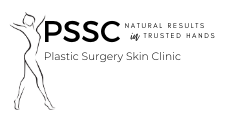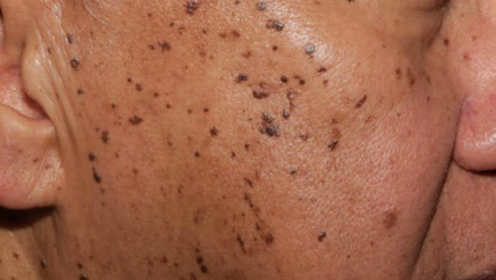If you look in the mirror one day and notice a new skin blemish, would you be able to identify it? It’s okay if your answer is “probably not” or “no”. The world of blemishes – hyperpigmentation in particular – is confusing. It’s common for people to misdiagnose, making it difficult to get to the root cause and treat it properly.
But fortunately, you don’t need an app for that—we’re here to help you out. We’ve put together a visual guide that can help you spot hyperpigmentation types, so you can treat them properly with full peace of mind.
1. Melasma
Description: Also known as the “mask of pregnancy”, melasma appears as darkened, uneven patches that invade the forehead, nose, cheeks, and upper lip. Occasionally, it can appear on the neck, shoulders, or even the forearms.
Who it Affects Most: Melasma affects women more often, especially those who are pregnant (hence the nickname, “mask of pregnancy”). But, it’s also quite common among women using hormone-based contraceptives, like birth control pills.
Causes: The condition likely stems from hormonal changes, which is why pregnancy and the use of birth control are common triggers for melasma. However, sun exposure and having a genetic predisposition can also cause this condition.
Treatment: Topical creams may work, but their efficacy is limited. In-clinic treatments such as chemical peels, microneedling, and laser therapy can reduce melasma over weeks and months.
2. Sunspots (Solar Lentigines)
Description: Also known as age spots and often seen as a sign of “getting up there”, sunspots are flat, brown marks that usually appear on sun-exposed areas. That includes the face, hands, and arms.
Who it Affects Most: Sunspots usually strike older adults, especially those with a long history of sun exposure. That’s another reason to wear sun protection regularly!
Causes: The main cause of sunspots is exposure to excessive sunlight and UV radiation, which trigger excess melanin production. However, aging itself can accelerate the appearance of sunspots, as our skin gets less able to heal itself as the years pass.
Treatment: The first line of defense is sun protection. That means wearing sunscreen and avoiding overexposure. However, sunspot removal may involve laser therapy, cryotherapy, and chemical peels.
3. Post-Inflammatory Hyperpigmentation (PIH)
Description: PIH produces flattened areas of discoloration that emerge after an injury to or inflammation of the skin.
Who it Affects Most: Anyone can get these discolored patches, however, individuals with darker skin tones are more likely to be affected.
Causes: Just about any injury or skin condition can lead to PIH marks—the causes are endless. That said, acne, burns, and cuts are some of the usual suspects behind these blemishes.
Treatment: Topical lightening creams and retinoids can help, but deeply set sunspots need more aggressive treatment. Some of the better treatments include chemical peels and laser treatments, as they target the levels of skin where PIH marks are rooted.
4. Freckles (Ephelides)
Description: Oh, how can we hate freckles? They’re cute and gifted to many by nature. They hardly need an introduction—small, flat, reddish-brown marks that mainly populate the face and arms.
Who it Affects Most: Freckles tend to appear on individuals with fairer skin, and who have red or blonde hair. But even people of color and darker hair shades can get freckles too.
Causes: The main cause of freckles is having a genetic predisposition to them. Sun exposure is the main cause of people who acquire freckles over time.
Treatment: Frankly, we should tell you that freckles don’t need treatment, especially if you were born with them—embrace them. Nevertheless, in-clinic treatments such as laser therapy and cryotherapy are available to those who want to remove freckles.
5. Lentigines
Description: “Lentigines” is just a fancy name for “liver spots” or “age spots”. They assume the form of small, dark areas on the skin that resemble freckles, although they’re different.
Who it Affects Most: You’re more likely to see middle-aged and older adults walking around with lentigines. They’re also more likely to appear on people with fairer skin, who have blue or green eyes and blonde or red hair.
Causes: Despite having the ominous name “liver spots”, lentigines are benign. Rarely, chronic illnesses and medications may cause them, but the typical culprits are aging and sun exposure.
Treatment: Like freckles, lentigines don’t require treatment, but laser therapy, cryotherapy, and chemical peels are effective for those looking to remove these spots.
6. Drug-Induced Hyperpigmentation (DIH)
Description: DIH assumes the form of darkened skin areas, which can appear throughout the body.
Who it Affects Most: DIH is the most indiscriminate form of hyperpigmentation on this list. No particular group has a higher or lower risk—those who develop DIH may just have an exaggerated response to medicines due to their unique makeup.
Causes: As its name suggests, DIH is caused by a reaction to specific drugs. The most common triggers are antimalarials, antipsychotics, chemotherapy drugs, and tetracyclines.
Treatment: Generally, discontinuing or switching/adjusting medications will cause the discoloration to disappear. However, if it lingers, in-clinic treatment, namely, laser therapy, can help speed up their removal.
7. Linea Nigra
Description: Linea Nigra is the medical term for that mysterious, dark vertical line running down the abdomen during pregnancy.
Who it Affects Most: Pregnant women—you certainly won’t see it anywhere else.
Causes: The main cause of linea nigra is hormonal changes brought on by pregnancy.
Treatment: Time heals all wounds and although linea nigra isn’t a wound per se, it too disappears on its own as time passes. However, if you want to speed the process up, laser therapy can be your answer to treatment.
8. Acanthosis Nigricans
Description: If you’ve ever seen photos of dark, velvet-like patches in skin folds and body creases, then you likely saw acanthosis nigricans.
Who it Affects Most: Dark-skinned people are more likely to develop this type of hyperpigmentation, although it can affect individuals with fairer skin tones as well.
Causes: This form of hyperpigmentation has more sinister causes, the main being insulin resistance, which is a precursor to diabetes. It can also be associated with hormonal disruption and obesity.
Treatment: Acanthosis nigricans typically fades once you treat the underlying disorder. That would mean balancing your blood sugar (in the case of diabetes) or losing weight (in the case of obesity). However, laser therapy can work as a complement to speed up your results.
9. Seborrheic Keratosis
Description: Seborrheic keratoses are noncancerous skin growths with either a brown, black, or light tan color.
Who it Affects Most: These growths occur most commonly in middle-aged and older adults, although they can rarely affect younger people as well.
Causes: The triggers of seborrheic keratosis are still under investigation, but aging is a culprit. Researchers are also looking into possible genetic factors.
Treatment: Since these growths can be stubborn, there’s a wide range of treatments to consider, especially ones in clinical settings. They include the likes of cryotherapy, laser therapy, electrosurgery, and curettage.
Hitting the Marks Where It Counts
When it comes to treating hyperpigmentation, you shouldn’t have to play the detective. Identifying what you’ve got should be straightforward so that you can treat it asap—that is, if you’re pressed to have it removed. With this visual guide, you can make a quick comparison with your skin condition and the images present here.
Of course, we don’t encourage you to self-diagnose either. Make sure to visit a dermatologist or cosmetic surgeon who can give you a more thorough analysis, diagnosis, and treatment plan.
Here at PSSC, we offer all of the above, ensuring you get a quick answer and solution to your hyperpigmentation issues. That way, you can restore your looks and confidence sooner, rather than later.
Get in touch with us to help you treat hyperpigmentation for long-lasting results you can be proud of!

